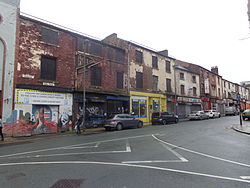53°47′44″N 1°32′26″W / 53.79548°N 1.540446°W / 53.79548; -1.540446



The 1st White Cloth Hall is a Grade II* listed building on Kirkgate, in the city centre of Leeds in West Yorkshire, England.
History
Originally named The White Cloth Hall, it was opened in 1711 as a response to the building of a covered cloth hall by the merchants of Wakefield in 1710, built in order to entice traders away from Leeds. So the cloth hall for the sale of white (undyed) cloth was built on Kirkgate on a site provided by Lord Irvine of Temple Newsam with £1,000 given by merchants and tradesmen. It was 'built upon Pillars and Arches in the form of an Exchange, with a Quadrangular Court within'.
Present
Despite its importance to the industrial heritage of Leeds and to the Industrial Revolution in general, the first White Cloth Hall in Kirkgate has stood growing increasingly derelict for many years surrounded by scaffolding and safety hoardings. The Amusement Arcade in its eastern wing still operates but the rest of the building is getting close to state of collapse and is a health and safety hazard.
A series of meetings with the City Council Planning Officers, the building owner Emco, and English Heritage, concluded that the western and southern sections of the building must be demolished.
In March 2018, Leeds City Council granted Rushbond Group permission to restore the building. Rushbond Group are local property developers who bought the building over a year earlier. Work started in March 2019.
In 2019 Historic England commissioned dendrochronological (tree-ring) analysis on ex situ samples from 19 oak and one conifer timbers from the former west range of First White Cloth Hall. This analysis dated the timber as growing during the years AD 1366–1476, with the trees felled in the summer of AD 1476, with a likelihood that the timbers were part of a specific programme of felling and construction from a single woodland source relatively local to West Yorkshire. This date is earlier than had been expected based on the opening of First White Cloth Hall in the early eighteenth century.
See also
References
- "Leeds First White Cloth Hall: public consulted on revamp". BBC News Online. 22 April 2011. Retrieved 12 November 2014.
- Iqbal, Aisha (27 June 2014). "Historic Leeds trading hub all set for a new lease of life". Yorkshire Evening Post. Yorkshire Post Newspapers. Retrieved 12 November 2014.
- ^ "First Cloth Hall (465922)" (PDF). Leeds Civic Trust. Archived from the original (PDF) on 25 March 2016. Retrieved 23 May 2016.
- "Leeds' First White Cloth Hall restoration plans approved". BBC News Online. 8 March 2018. Retrieved 30 June 2021.
- Newton, Grace. "Builders make fascinating archaeological finds on the site of Leeds' oldest street". The Yorkshire Post. Archived from the original on 9 December 2019. Retrieved 30 June 2021.
- Arnold, Alison; Howard, Robert; Tyers, Cathy; Tyers, Ian (2019). Former West Range, First White Cloth Hall, 100 Kirkgate, Leeds, West Yorkshire: Tree-ring Analysis of ex situ Timbers (Report). Historic England. ISSN 2398-3841. 52-2019. Archived from the original on 1 September 2020. Retrieved 30 July 2021.
External links
- Historic England. "Details from listed building database (1375042)". National Heritage List for England.